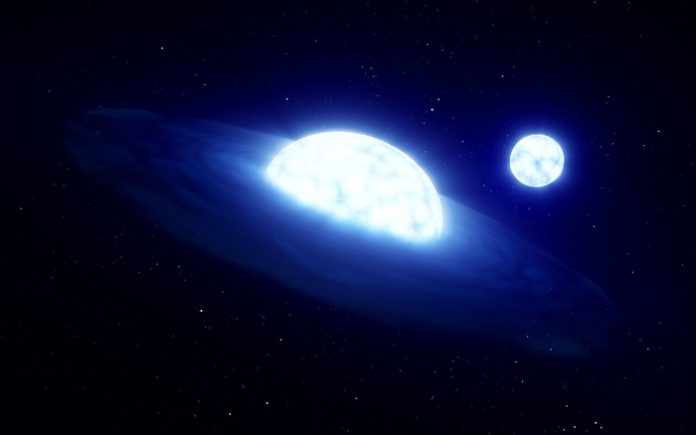It has been scientifically accepted that Earth’s closest black hole is about 1,000 light-years away – but now, research suggests that black hole doesn’t exist
The HR 6819 system – known colloquially as Earth’s closest black hole – is thought to instead be a “vampire” two-star system in a rare and short-lived stage of its evolution. In a paper published 2 March 2022, researchers report that there is in fact no black hole where it was previously thought to be.
Using a MPG/ESO 2.2-metre telescope, the original research team had deducted that the HR 6819 system was a “triple system”, with one star orbiting a black hole every 40 days and a second star in a much wider orbit.
However, Dr Julia Bodensteiner and her team from KU Leuven Belgium, proposed a different explanation for the same data: HR 6819 could also be a system with only two stars on a 40-day orbit and no black hole at all.
This alternative scenario would require one of the stars to be “stripped”, meaning that, at an earlier time, it had lost a large fraction of its mass to the other star.
“We had reached the limit of the existing data, so we had to turn to a different observational strategy to decide between the two scenarios proposed by the two teams,” said KU Leuven researcher Abigail Frost, who led the new study published today in Astronomy & Astrophysics.
Solving the mystery of the black hole
Since it made no sense to ask for the same observation twice, the two teams joined forces, which allowed them to pool their resources to find the true nature of this system – previously thought of as Earth’s closest black hole.
Having the two research teams working together, new data was collated using ESO’s Very Large Telescope (VLT) and Very Large Telescope Interferometer (VLTI). “The VLTI was the only facility that would give us the decisive data we needed to distinguish between the two explanations,” commented Dietrich Baade, author on both the original HR 6819 study and the new Astronomy & Astrophysics paper.
“The scenarios we were looking for were rather clear, very different and easily distinguishable with the right instrument,” said Thomas Rivinius, a Chile-based ESO astronomer and lead author on the orginal HR 6819 paper.
“We agreed that there were two sources of light in the system, so the question was whether they orbit each other closely, as in the stripped-star scenario, or are far apart from each other, as in the black hole scenario.”
Two sources of light?
In order to find out which proposal was correct the teams were able to use the VLTI’s GRAVITY instrument and the Multi Unit Spectroscopic Explorer (MUSE) instrument on ESO’s VLT.
“MUSE confirmed that there was no bright companion in a wider orbit, while GRAVITY’s high spatial resolution was able to resolve two bright sources separated by only one-third of the distance between the Earth and the Sun,” said Frost.
“These data proved to be the final piece of the puzzle, and allowed us to conclude that HR 6819 is a binary system with no black hole.”
“HR 6819 is a binary system with no black hole.”
“Our best interpretation so far is that we caught this binary system in a moment shortly after one of the stars had sucked the atmosphere off its companion star. This is a common phenomenon in close binary systems, sometimes referred to as “stellar vampirism” in the press,” explains Bodensteiner, now a fellow at ESO in Germany and an author on the new study. “While the donor star was stripped of some of its material, the recipient star began to spin more rapidly.”
“Catching such a post-interaction phase is extremely difficult as it is so short,” adds Frost. “This makes our findings for HR 6819 very exciting, as it presents a perfect candidate to study how this vampirism affects the evolution of massive stars, and in turn the formation of their associated phenomena including gravitational waves and violent supernova explosions.”
Joint team to monitor the phenomena
The newly formed joint team “Leuven-ESO” now plans to monitor HR 6819 more closely using the VLTI’s GRAVITY instrument.
The team will conduct a joint study of the system over time, to better understand its evolution, constrain its properties, and use that knowledge to learn more about other binary systems.
The team is still confident in its search for black holes with Baade stating that there are estimated to be tens to hundreds of millions of black holes in the Milky Way alone. With astronomers still hunting, it is only a matter of time before they find them.











